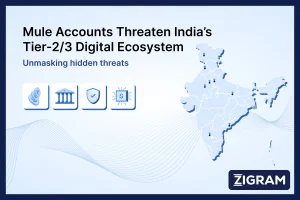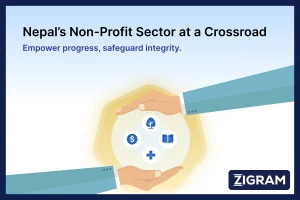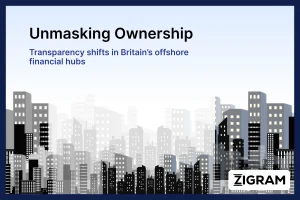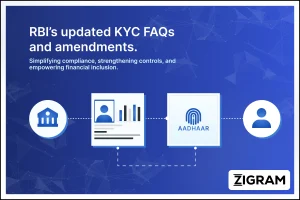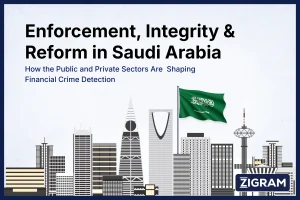In today’s global economy, businesses face an array of risks ranging from financial uncertainty to regulatory compliance and reputational damage. Amidst this landscape, due diligence has emerged as a critical process for mitigating risks, ensuring regulatory compliance, and safeguarding against potential threats. Enhanced Due Diligence (EDD) stands out as a robust methodology employed by businesses to delve deeper into the backgrounds of clients, partners, and third-party entities. By supplementing traditional due diligence processes with additional layers of scrutiny, EDD offers a comprehensive risk assessment framework.

Understanding Enhanced Due Diligence
Enhanced Due Diligence goes beyond basic background checks and standard verification procedures. It involves a more thorough investigation into the backgrounds of individuals or entities, focusing on gathering comprehensive information to assess potential risks and vulnerabilities. This heightened scrutiny is particularly relevant in sectors prone to money laundering, terrorism financing, corruption, or other illicit activities.
Types of Enhanced Due Diligence
Enhanced Due Diligence (EDD) reports are specialized investigations conducted to gather comprehensive information about individuals or entities. These reports are typically more thorough than standard due diligence reports and are often used in high-risk situations or when dealing with complex transactions. While the specific types of EDD reports may vary depending on the nature of the investigation and the requirements of the requesting party, here are some common types:
Background Checks:
These reports focus on verifying an individual's identity, employment history, education credentials, criminal record, and any other relevant background information.
Financial Due Diligence:
Financial EDD reports delve into the financial history and standing of an individual or entity, including their assets, liabilities, sources of income, and financial transactions.
Regulatory Compliance Checks:
These reports assess whether an individual or entity is compliant with relevant laws, regulations, and industry standards, particularly in areas such as anti-money laundering (AML), counter-terrorism financing (CTF), and sanctions compliance.
Politically Exposed Persons (PEP) Checks:
PEP checks focus on identifying individuals who hold prominent public positions or have close associations with such individuals. These reports aim to assess the potential risks associated with dealing with politically exposed persons.
Geopolitical Risk Assessments:
Geopolitical risk assessments analyze the political, economic, and social dynamics of a particular region or country to identify potential risks and opportunities for businesses operating in those areas.
Enhanced Sanctions Screening:
These reports involve comprehensive screening processes to identify individuals or entities that may be subject to sanctions imposed by governmental bodies or international organizations.
Enhanced Customer Due Diligence (CDD):
CDD reports focus on assessing the risk posed by customers or clients, including their identity, business activities, and potential involvement in illicit activities such as money laundering or terrorist financing.
Transaction Monitoring:
Transaction monitoring reports involve the analysis of financial transactions to detect suspicious or anomalous activities that may indicate money laundering, fraud, or other illicit activities.
Supply Chain Due Diligence:
Supply chain due diligence reports assess the integrity and reliability of suppliers, distributors, and other partners within a company's supply chain to identify potential risks such as labour exploitation, corruption, or environmental violations.
These are just some examples of the types of enhanced due diligence reports that may be conducted depending on the specific requirements of the situation or industry. The scope and depth of the investigation may vary based on factors such as the level of risk involved, regulatory requirements, and the nature of the business relationship.
Key Components of Enhanced Due Diligence
Identity Verification:
EDD starts with robust identity verification processes to ensure that the entity under scrutiny is who it claims to be. This may involve verifying identity documents, corporate records, and legal documentation.
Source of Funds:
Understanding the source of funds is crucial, especially in financial transactions. EDD aims to trace the origin of funds to ensure they are legitimate and not linked to criminal activities.
Beneficial Ownership:
Uncovering the true beneficial owners of a company or entity is a crucial aspect of EDD. This involves identifying individuals who ultimately own or control the entity, even if they are not listed as official owners.
Politically Exposed Persons (PEPs) Screening:
EDD includes screening for Politically Exposed Persons – individuals who hold prominent public positions – to assess the potential risk of bribery, corruption, or undue influence.
Risk-Based Approach:
EDD employs a risk-based approach, meaning that the level of due diligence conducted is proportionate to the perceived risk associated with the client or transaction. High-risk clients or transactions undergo more extensive scrutiny.
Ongoing Monitoring:
EDD is not a one-time process but an ongoing endeavour. Continuous monitoring of clients, partners, and transactions is essential to detect any changes in risk profile or suspicious activities over time.
Identifying High-Risk Customers for EDD
For EDD to be done we need to identify High-risk customers that encompass a diverse spectrum of individuals and entities, each presenting unique challenges and compliance concerns. These include:
Politically Exposed Persons (PEPs):
Individuals who hold or have held prominent public positions, along with their close associates, are often deemed high-risk due to the potential for corruption, bribery, or undue influence.
Customers with Complex Ownership Structures:
Entities with convoluted ownership arrangements, including offshore companies and trusts, can obscure beneficial ownership, raising concerns about transparency and accountability.
Non-Residential Customers:
Customers residing in jurisdictions known for weak regulatory oversight, high corruption levels, or active involvement in financial crimes are subject to heightened scrutiny.
Customers with Dubious Reputations:
Individuals or entities with a history of regulatory violations, criminal activities, or negative media coverage warrant closer examination to mitigate potential risks.
Customers with Links to High-Risk Countries:
Transactions involving parties from countries facing sanctions, embargoes, or significant geopolitical instability pose elevated risks due to the potential for money laundering, terrorism financing, or other illicit activities.
Customers Associated with High-Risk Industries:
Certain industries, such as gambling, cryptocurrency, and precious metals trading, are inherently susceptible to financial crimes, necessitating enhanced due diligence measures.
Customers with Unusual Account Activity:
Patterns of unusual or suspicious account activity, including large cash deposits, frequent international transactions, or sudden changes in transactional behaviour, may indicate potential risks requiring further investigation.
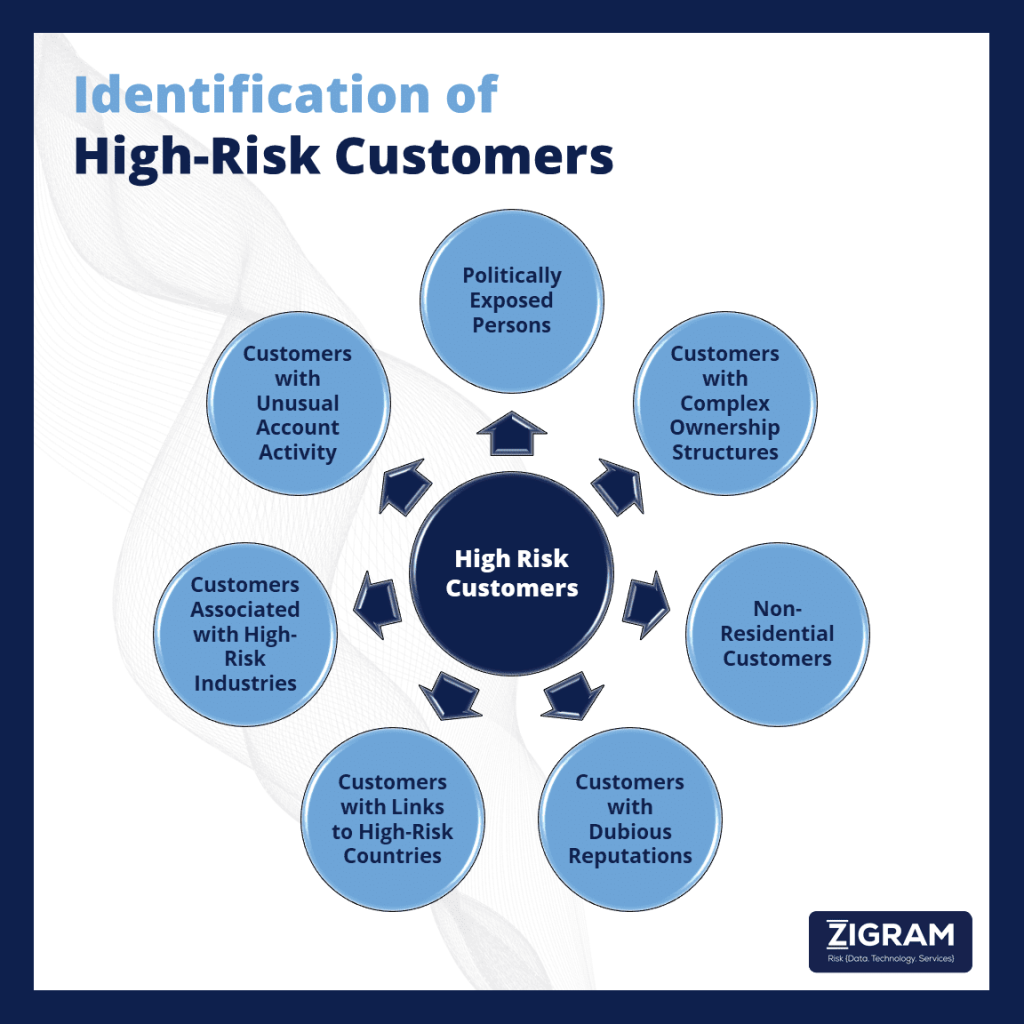
EDD Requirements for High-Risk Customers
Enhanced Due Diligence mandates organizations to collect comprehensive information about high-risk customers to assess potential risks effectively. Key requirements include:
Business Information:
For corporate customers, obtaining detailed information about ownership structures, key stakeholders, and business activities is essential to understanding potential risks.
Beneficial Ownership:
Identifying the individuals who ultimately own or control customer entities helps mitigate risks associated with concealed ownership and shell companies.
Source of Funds:
Clarifying the legitimate sources of customers' wealth and funds is crucial for ensuring transactions are free from illicit activities.
Enhanced Identity Verification:
Implementing robust identity verification processes, including additional documentation or verification methods such as biometric authentication, helps mitigate identity fraud risks.
Risk Indicators:
Evaluating various customer-specific risk factors, such as geographic location, industry, transactional behaviour, and past regulatory issues, enables organizations to assess and mitigate potential risks effectively.
Why Enhanced Due Diligence Matters
Enhanced Due Diligence plays a pivotal role in strengthening anti-money laundering (AML) programs, ensuring compliance with regulatory requirements, and safeguarding against financial crimes. Its importance is underscored by several factors:
Efficient Compliance Workflows:
EDD enhances overall AML compliance by providing deeper insights into customers' financial activities, streamlining onboarding processes, and enabling real-time monitoring to address potential issues promptly.
Accurate Risk Management:
Gathering additional information about high-risk customers enables organizations to better understand associated risks, detect suspicious activities, and minimize the likelihood of financial crimes.
Improved Internal Controls:
EDD enhances internal processes related to AML programs, such as screening for PEPs and sanctions, thereby bolstering the effectiveness of compliance efforts and reducing exposure to regulatory risks.
When is Enhanced Due Diligence Required?
The Financial Action Task Force (FATF) recommends integrating Enhanced Due Diligence measures into AML/CFT processes for new business relationships, occasional transactions with suspicion of money laundering or terrorism financing, and cases involving unreliable documentation. Monitoring should be an ongoing obligation rather than a one-time requirement.
Best Practices for Enhanced Due Diligence
FATF recommends five best practices for EDD, including obtaining
- Additional identifying information,
- Conducting extra searches,
- Verifying the source of funds,
- Collecting information on the purpose of business relationships, and
- Initiating intelligence reports on customers or beneficial owners.
Examples of Customers Requiring EDD
Common examples of customers requiring EDD include:
- PEPs or known criminals,
- Businesses engaged in anonymous transactions,
- Cash-intensive enterprises,
- Entities with unclear ownership structures,
- Non-resident customers, and
- Companies operating in high-risk jurisdictions.
Benefits of Enhanced Due Diligence:
Risk Mitigation:
By conducting thorough investigations, businesses can identify and mitigate potential risks, including financial crimes, reputational damage, and regulatory violations.
Compliance:
EDD helps businesses comply with regulatory requirements, particularly in industries subject to stringent anti-money laundering (AML) and know your customer (KYC) regulations.
Protecting Reputation:
Proactively identifying and addressing risks through EDD can safeguard a company's reputation and credibility in the market.
Strengthening Business Relationships:
EDD instils trust and confidence in business relationships by demonstrating a commitment to integrity and compliance with ethical standards.
Legal Protection:
Implementing robust EDD practices can provide legal protection by demonstrating due diligence in the event of any regulatory scrutiny or legal proceedings.
Distinguishing Customer Due Diligence (CDD) from Enhanced Due Diligence (EDD)
While both Customer Due Diligence (CDD) and Enhanced Due Diligence (EDD) are integral components of risk management and compliance efforts, it's crucial to understand the distinctions between the two processes.
Customer Due Diligence (CDD)
CDD is the foundational level of due diligence businesses conduct as part of their standard procedures to assess the risk associated with a customer or client. The primary objective of CDD is to verify the identity of customers, understand the nature and purpose of their business relationship with the company, and assess the level of risk they pose.
Key components of CDD include:
- Identity Verification: Verifying the identity of customers through documentation such as government-issued IDs, passports, or utility bills.
- Understanding Business Activities: Gaining insights into the nature of the customer's business, including its operations, industry, and transaction patterns.
- Assessing Risk: Conducting risk assessments to categorize customers based on their risk profiles, such as low, medium, or high risk.
CDD is typically conducted for all customers as part of routine onboarding processes and is mandated by regulatory requirements in various jurisdictions.
Enhanced Due Diligence (EDD)
Enhanced Due Diligence (EDD) goes beyond the standard procedures of CDD and involves a more comprehensive and rigorous investigation, particularly for customers or transactions deemed to pose higher risks. EDD is typically triggered by factors such as the customer's risk profile, transactional red flags, or regulatory requirements.
Key distinctions of EDD include:
- Heightened Scrutiny: EDD involves a deeper level of scrutiny, including additional research and analysis, to gather comprehensive information about the customer's background, source of funds, and beneficial ownership structure.
- Politically Exposed Persons (PEPs) Screening: EDD mandates screening for Politically Exposed Persons (PEPs) and their close associates to assess the risk of potential corruption, bribery, or undue influence.
- Ongoing Monitoring: While CDD is often a one-time process conducted during customer onboarding, EDD may necessitate continuous monitoring of high-risk customers and transactions to detect any changes in risk profiles or suspicious activities over time.
Integration and Synergy
While CDD and EDD serve distinct purposes, they are complementary processes that together form a robust risk management framework. CDD lays the groundwork by establishing the baseline level of due diligence for all customers, while EDD provides an additional layer of scrutiny for high-risk entities or transactions, thereby enhancing the effectiveness of risk mitigation efforts.
By understanding the differences between CDD and EDD and integrating them seamlessly into their compliance programs, businesses can strengthen their risk management practices, comply with regulatory requirements, and safeguard against potential threats more effectively.
Challenges and Considerations
RegTechs, driving efficiency and compliance in finance, are projected to reach a market value of USD 60.77 billion by 2030, according to Fortune Business Insights, offering advanced solutions to manage regulatory risks and enhance operational compliance. Institutions are increasingly turning to AI-enabled RegTechs to streamline Despite its benefits, implementing EDD can pose challenges for businesses. These may include resource constraints, access to reliable information, and navigating complex regulatory landscapes across different jurisdictions. Moreover, balancing the need for enhanced scrutiny with customer experience and operational efficiency is a delicate task.
Additionally, relying solely on automated tools or technology for EDD may not always suffice, as human judgment and expertise are often necessary to interpret complex information and detect nuanced risks.
EDD is a critical component of modern risk management and compliance efforts, particularly in industries susceptible to financial crimes. While challenges exist, businesses continue to invest in EDD measures to mitigate risks, comply with regulatory requirements, and safeguard their reputations and financial integrity.
Trends for Enhanced Due Diligence
While specific figures and statistics regarding Enhanced Due Diligence (EDD) adoption and its impact may vary depending on the industry and geographical region, several general facts and trends provide insights into the prevalence and importance of EDD in modern business practices:
Regulatory Mandates:
Regulatory bodies worldwide, including financial regulators, anti-money laundering (AML) authorities, and government agencies, have increasingly emphasized the importance of EDD in combating financial crimes. For instance, the Financial Action Task Force (FATF), an intergovernmental organization focused on AML and counter-terrorism financing, provides guidelines and recommendations for EDD implementation.
High-Risk Industries:
Certain industries, such as banking, insurance, real estate, and gaming, are particularly susceptible to money laundering and financial crimes. As a result, businesses operating in these sectors often prioritize EDD to mitigate associated risks. For instance, in the real estate sector, where anonymous transactions can facilitate money laundering, EDD measures are increasingly being implemented.
Global Impact:
EDD is not limited to specific jurisdictions but is a global phenomenon driven by international efforts to combat financial crimes and ensure regulatory compliance. With the increasing interconnectedness of global financial systems, the need for robust EDD measures has become more pronounced.
Costs and Resource Allocation:
Implementing EDD measures can incur significant costs for businesses, including investments in technology, personnel training, and ongoing monitoring efforts. However, the costs of non-compliance, including fines, legal penalties, and reputational damage, often outweigh the expenses associated with EDD implementation.
Effectiveness:
While EDD is recognized as a crucial component of AML and compliance programs, its effectiveness in detecting and preventing financial crimes can vary depending on various factors, including the quality of data, the sophistication of risk assessment methodologies, and regulatory oversight.
Future Trends:
As regulatory requirements evolve and financial criminals adapt their tactics, the landscape of EDD is expected to continue evolving. Future trends may include increased collaboration between public and private sectors, the integration of emerging technologies such as blockchain and digital identity verification, and enhanced cross-border cooperation to combat global financial crimes.
It is an indispensable tool for modern businesses navigating an increasingly complex and interconnected global landscape. By adopting a risk-based approach and implementing robust investigative processes, businesses can effectively mitigate risks, ensure regulatory compliance, and protect their reputations. As regulatory expectations evolve and risks continue, embracing enhanced due diligence remains critical for fostering trust, integrity, and resilience in today's business environment.
- #Due_Diligence
- #AI
- #Financial_Fraud_Detection
- #Risk_Management


